Photographs: Rajesh Karkera/Rediff.com
It is the only Indian destination mentioned in Forbes magazine's list of '13 cultural events to be seen' across the world.
Set in the historical port town of Kochi, India's first ever new-age art extravaganza, the Kochi-Muziris Biennale, has received great response from the global art world.
Durga Dominic brings you a glimpse of some of the exciting Indian artists participating in the Biennale.
Photographs: Rajesh Karkera
Also in the series:
The incredible Kochi Biennale!
Kochi Biennale: Art that challenges!
Nalini Malani: Mumbai
Nalini Malani belongs to a new generation of women artists who weave personal narratives and histories into their practice.
She is also part of India's first-generation of video artists.
Malani is committed to the role of the artist as a social activist. Her multimedia works take a stand on the politics of gender, the destruction of the ecology, the abuse of power and spread of injustice.
Her politically motivated works have been shown in major exhibitions in India, Japan, Australia, England, Cuba and South Africa and are represented in national museum collections worldwide.
Her video installation at the Kochi Biennale is called In Search Of Vanished Blood.
Artist information courtesy Herning Museum of Contemporary Art, Saffronart.com
...
Prasad Raghavan: New Delhi
Image: Prasad Raghavan's The Ship of TarshishPhotographs: Rajesh Karkera/Rediff.com
Malayali artist Raghavan began his forays into world of art by making posters of his movie club a:door.
Raghavan's Biblically-inspired installation at the Kochi Biennale, titled The Ship of Tarshish, shows a vessel poised for spice trade from Kerala to the West.
The work is set against the country's newest international container terminal in Kochi's Vallarpadam across the lakeside Biennale venue, with a view of the Arabian Sea.
Artist information courtesy: prasadraghavan.com; financialexpress.com
...
K P Reji: Baroda
Image: K P Reji with Thumbinkal ChatanPhotographs: Rajesh Karkera/Rediff.com
Despite -- or perhaps because of -- their apparent simplicity, K P Reji's paintings are enigmatic.
His work is multifaceted and complex in its analysis of the individual's relationship to his external environment.
Reji's contribution to the Kochi Biennale is titled Thumbinkal Chatan. "The myth of Thumbinkal Chathan formed the basic foundation for my painting."
Regi's huge oil painting depicts a man lying down to form a dam, sacrificing his life and saving the farmland. He has drawn upon oral histories from the region to convey to the viewer a sense of 'his Kerala'.
Though Reji now lives in Baroda, he was born in a small village in God's own country.
Artist information courtesy saffronart.com; kochimuzirisbiennale.org
...
Reghunadhan K: Kochi
Image: Reghunandhan's ConservatoryPhotographs: Rajesh Karkera/Rediff.com
Reghunadhan's work draws energy directly from the tradition of the great satirists of his home state, Kerala.
While telling stories, Reghunadhan meanders constantly from topic to object to person and ends with the stories of totally disconnected people or places.
Neither the telling, nor the tale is pre-planned, The end result often breaks every reason and logic. He appears to be making a statement, then appears to be contradicting that very statement.
Reghunandhan has titled his sculpture at the Kochi Biennale, Conservatory. He explains it thus: A conservatory is a room typically attached to a house that is used as a greenhouse or storage. Sometimes they conserve the extinct and the abandoned. The sculptures are stored away, as are the concepts and memories around them, many of which ar not revealed.
Artist information courtesy thecityguide.in
...
Rohini Devasher: Delhi
Image: Rohini Devasher's Parts UnknownPhotographs: Rajesh Karkera/Rediff.com
Rohini Devasher, who is counted among India's finest young artists, has created a suite of seven videos for the Biennale.
Titled Parts Unknown, these videos were shot at Hanle, a high altitude observatory in Ladakh. It is a window to a strangely mythic landscape, and transforms our imagination's concept about remote objects.
Parts Unknown, Devasher said, fell into place when she saw the room where her work is currently displayed. The charting of the constellation, which is part of her work, was helped by the grid formed by the roof and the rafters.
Artist information courtesy kochimuzirisbiennale.org
...
Srinivasa Prasad: Bangalore
Image: Srinivasa Prasad's ErasePhotographs: Rajesh Karkera/Rediff.com
Srinivasa Prasad likes creating large-scale installations that are site-specific and deeply rooted in culture and tradition. He uses natural materials such as mud, hay, water, grains, cow dung, etc, to create his work.
His exhibit at the Kochi Biennale, titled Erase, is a thorny 'cocoon' that hangs suspended over a set of steps made with filled gunny sacks.
Visitors can insert their head and shoulders into the opening of the prickly hollow of the cocoon, where they are encouraged to leave their bad and unwanted thoughts, memories and fears.
At the end of the viewing period, the cocoon is set ablaze at night in a ritual that destroys the structure along with the thoughts, memories and confessions uttered within in.
Artist information courtesy arcus-project.com
...
Anant Joshi: Mumbai
Image: Anant Joshi's Three Simple StepsPhotographs: Rajesh Karkera/Rediff.com
Anant Joshi draws inspiration from cultural icons and architectural monuments such as the Zhengyangmen in Beijing, or the Gateway of India in Mumbai.
For the Biennale, he has built a replica of a typical Kerala temple.
"Much is said about the cosmopolitan nature and inclusiveness of Kochi. It has a rich history of people from other countries and cultures being absorbed here," he says. But, he admits, he is a little cynical about the same.
His installation, which is titled Three Simple Steps, isn't just about inviting people in, he says. It is also growing from within.
He has replaced the lamps which are typically seen on the temple walls with the mosquito repellent machines. This is why one is hit by an extremely strong, nearly unbearable fragrance as one enters the room where his work is exhibited.
He draws a simile to Kochi, of how when the fragrance is subtle it is bearable but too much of it makes you want to push it away.
Artist information courtesy westheavens.net
...
Subodh Gupta: New Delhi
Image: Subodh Gupta's untitled installationPhotographs: Rajesh Karkera/Rediff.com
Subodh Gupta's creations encompass sculpture, installation, painting, photography, performance and video.
He is best known for transforming ubiquitous everyday objects from India -- such as steel tiffin boxes, thalis, bicycles and milk pails -- into artworks that are readable globally.
His display at the Kochi Biennale initially looks like a mere boat. When you look closer, you realise he has developed the microcosm of the boat as an entity that contains the entire existence of a person, his basic needs, the entire worth of his material possessions, bundled and thrust into the vessel upon which he has set sail.
The boat suggests notions of migration and survival, experienced most acutely by the deprived masses of society.
Artist information courtesy Wikipedia
...
Anup Mathew Thomas: Bangalore
Image: Anup Mathew Thomas's photographic seriesPhotographs: Rajesh Karkera/Rediff.com
Visual artist Anup Mathew Thomas prefers photography as his medium of choice.
In 2006, he documented bishops from different Christian denominations in Kerala. The work, titled Metropolitan, comprised a series (Thomas's favoured format) of 14 large format photographs of Episcopalian bishops.
According to the information posted alongside Thomas's work at the Kochi biennale: 'Thirunilathu Vaakachan Paul runs a ration shop in Konthuruthy. In 1987, he started collecting discarded obituary cards from the church near his shop. Paul's friend Pappachan got him a wooden board to display the cards.
When Paul ran out of space on the first board, Pappachan's son John Mathai presented him with a second one.
Paul continues to put up obituary cards from the area and hopes to be around to add a few more boards. His customers help him with obituaries that may have escaped his attention.
Sometimes, natives of Konthuruthy, who live elsewhere, stop by at Paul's shop when they are in town to find out who may have passed since their last visit.'
Artist information courtesy Wikipedia
...
Valsan Koorma Kolleri: Pattiam, Kerala
Image: Valsan Kolleri's installation advocates the art of recyclingPhotographs: Rajesh Karkera/Rediff.com
Valsan Kolleri creates eloquent and moving sculptures using wood, leather, bones, hair, nests and hives -- things that have been discarded because they have aged or lost their value in the quest for novelty.
Turning loss to advantage, he creates a theatre where these things are reinstated.
"Art is organic," he says. "There is a beautiful way of keeping anything you see, even a stone."
At the Kochi Biennale, Kolleri uses a tiny back room, filled roof to floor with shelves. Each of these shelves contain an item found everywhere in Kerala -- woven palm leaf, clay objects, a pyramid of rice husk.
Explaining his installation, he says, "When something breaks, people discard it... By reusing it, the material can be reborn. One could make something better than what it was. The time has come for us to think of art of recycling.
Artist information courtesy shilpapaddiam.com
...
T Venkanna: Baroda
Image: T Venkanna's PanchamahabhutaPhotographs: Rajesh Karkera/Rediff.com
T Venkanna's prolific output has gained him the reputation of being one of his generation's most exciting, versatile and unconventional artists.
His exhibit at the Kochi Biennale is titled Panchamahabhuta (The Five Elements).
Venkanna has created five large new works on canvas, displayed along with five objects depict the delicate state of the five main elements in nature -- earth, water, air, fire and sky.
He highlights the fact that the harmony between these elements is increasingly imbalanced due to human greed.
Artist information courtesy vipart.com; mattersofart.blogspot.in
...
Sheela Gowda and Christoph Storz: Bengaluru
Image: Sheela Gowda and Christoph Storz's StopoverPhotographs: Rajesh Karkera/Rediff.com
Sheela Gowda and Christoph Storz chose the Kochi waterfront as the site for their installation, Stopover, which pays tribute to that once-ubiquitous kitchen aid, the grinding stone.
Houses built half a century ago had the grinding stone sunk into the floor. The women in the house would turn the pestle in its hole to grind the spices needed for the day.
With the increasing popularity of the electric mixer, the grinding stone was abandoned.
With the escalated value of real estate, old houses were demolished or renovated for modern living.
However, unlike the rubble that was transported away as debris, no one dared to wilfully destroy the grinding stone. It was too full of the memory of its use, and its destruction would be an act of irreverence.
It is therefore 'let loose', as if into nature, in the same manner that male calves and cows that do not give milk are let loose on the streets.
The stone does not go very far, sometimes only a little further, to the base of an electric pole or into the quiet of a side street, to join other grinding stones already resting there.
Eventually, the togetherness of the grinding stones turns the location into a cemetery in its own right.
There they lie and no one sees them anymore. They become invisible.
Gowda and Storz say that, with the 'stop over' of 170 of these stones at Kochi, a port of defunct spice trade, they are try to shift the grinding stones and their story back into visibility.
The installation is about a shift, about a change of positions.
Artist information lemondesign.blogspot.in
...
Sudarshan Shetty: Mumbai
Image: Sudarshan Shetty's I Know Nothing Of The EndPhotographs: Rajesh Karkera/Rediff.com
Sudarshan Shetty is becoming increasingly visible on the international stage as an important voice in contemporary art. His works include painting, sculpture, installation, video, sound and performance.
His exhibit at the Biennale, which represents a fake architectural site, is titled I Know Nothing Of The End.
'When you make a monument for someone or in my case, for no one in particular, it becomes a meaningless exercise,' explains Shetty. 'That is why it is fake. My idea is to build that meaninglessness into the making of the monument.'
I Know Nothing Of The End is built in three pits and questions the notion of constantly building memorials. 'To what extent can these memories be true to living people is anybody's guess,' he says.
Artist information courtesy Wikipedia.
...
Vivan Sundaram: New Delhi
Image: Vivan Sundaram's interpreted reconstruction of the lost city of MuzirisPhotographs: Rajesh Karkera/Rediff.com
Contemporary artist Vivan Sundaram creates his own version of the lost city of Muziris, the ancient seaport that existed in south India in the first century.
The installation, titled Black Gold, includes a video on the artistic recreation of Muziris through pottery shards and black pepper.
A hawk-eye like camera captured the process of flooding the pottery shards to leave the 'city' under water, later adding 15 kgs of pepper to the water to create a 'strange, mysterious landscape like maybe the moon,' says Sundaram.
He is known to work in many different media, including painting, sculpture, printmaking, photography, installation and video art.
His works constantly refer to social problems, popular culture, problems of perception, memory and history. He was among the first Indian artists to work with installation.
Artist information courtesy Wikipedia.
...
K P Krishnakumar: Kerala (1958 to 1989)
Image: Two of the late K P Krishnakumar's works have been exhibited at the BiennalePhotographs: Rajesh Karkera/Rediff.com
At age 31, this brilliant sculptor-painter ended his life.
Two of his works have been exhibited at the Biennale, as a token of respect to K P Krishnakumar and the brief radical art movement –- it lasted just a couple of years -- that he began.
Art scholar Geeta Kapur, whose artist husband Vivan Sundaram's work is also displayed at the Biennale, says in her book, When Was Modernism: Essays on Contemporary Cultural Practice in India: 'This Kerala–Baroda group hammered out a militant agenda, arguing that Indian art required a radical interrogation of political and aesthetic issues. K P Krishnakumar adopted a heroic agenda in his tragically brief career. He used the figural gesture, often profoundly comic, to taunt the viewer and also to signal faith in the sculptural presence itself.'
Artist information courtesy Wikipedia
...
Atul Dodiya: Mumbai
Image: Atul Dodiya's Celebration In The LaboratoryPhotographs: Rajesh Karkera/Rediff.com
An entire floor has been devoted to famed Indian artist Atul Dodiya's exhibit, Celebration In The Laboratory.
Dodiya has always been known for his paintings; this is his first photo installation. It houses 231 photographs (selected from a vast base of over 7,000 photographs) he has chosen of people who have contributed in some ways to Indian art in the last 70 years.
It depicts Dodiya's view that the Indian art scene is exactly like a large joint family.
Information courtesy kochimuzirisbiennale.org
...
Vivek Premachandran aka UBIK: Dubai
Image: UBIK has created three text-based installationsPhotographs: Rajesh Karkera/Rediff.com
Kerala-born artist Vivek Premachandran, aka UBIK, tackles the heaviness of history in three nimble, text-based installations.
"This is really a DIY biennale," he said. "It's like boot camp for a young artist like me. These are some of the legends of modern and contemporary art in India, and I get to see their working process out in the open and in public."
UBIK's works experiments with a variety of mediums, without restriction to a specific genre. The viewer is not an isolated agent in his creations; his reaction is an integral part of the artistic production.
Artist information courtesy artforum.com.

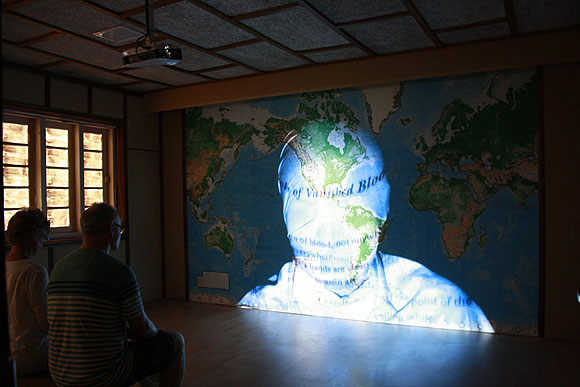
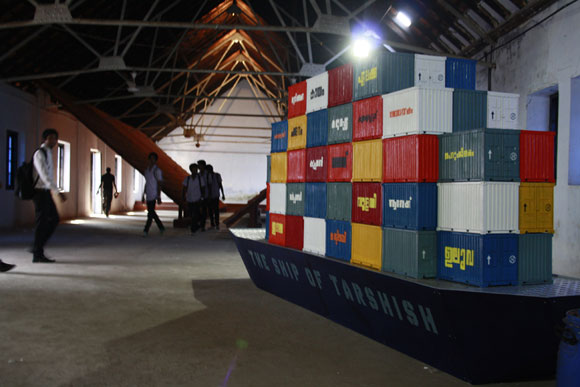
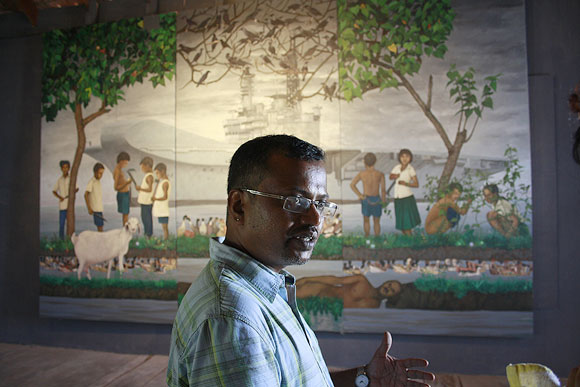
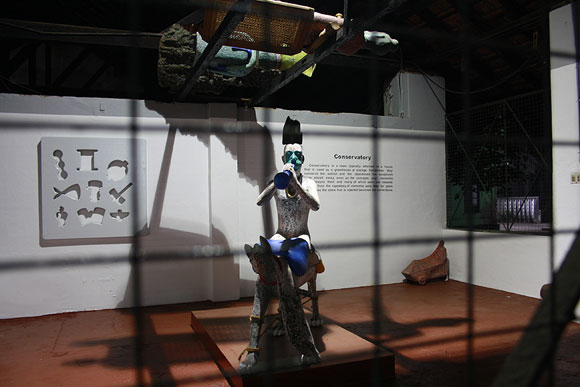
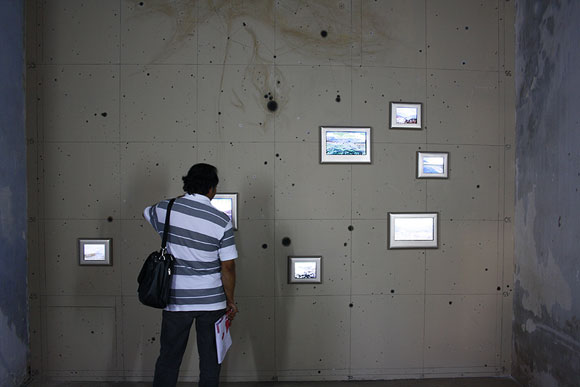
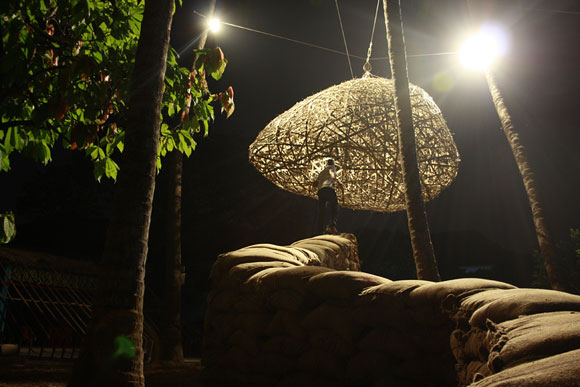
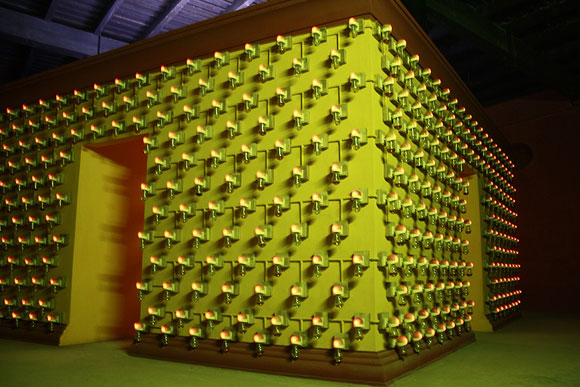
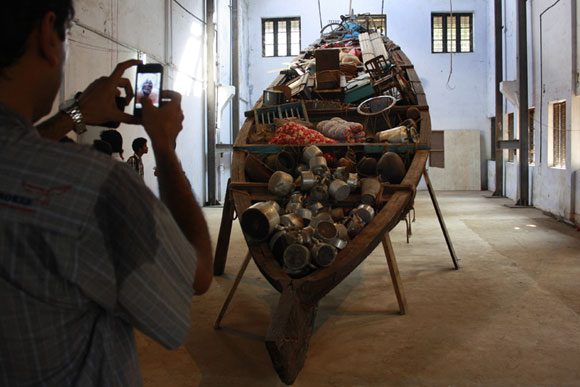

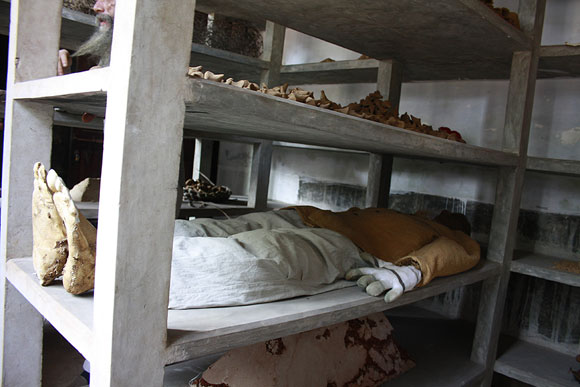

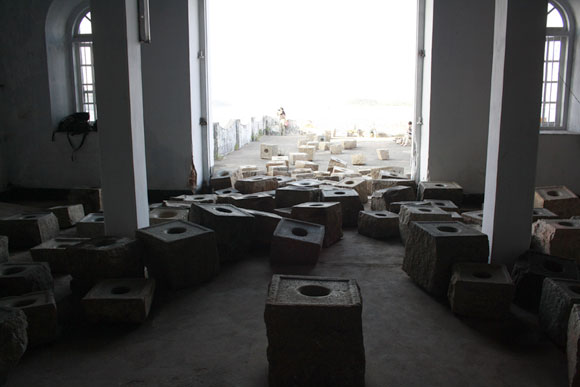
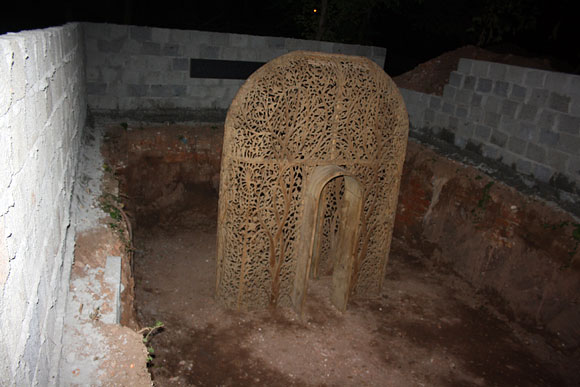
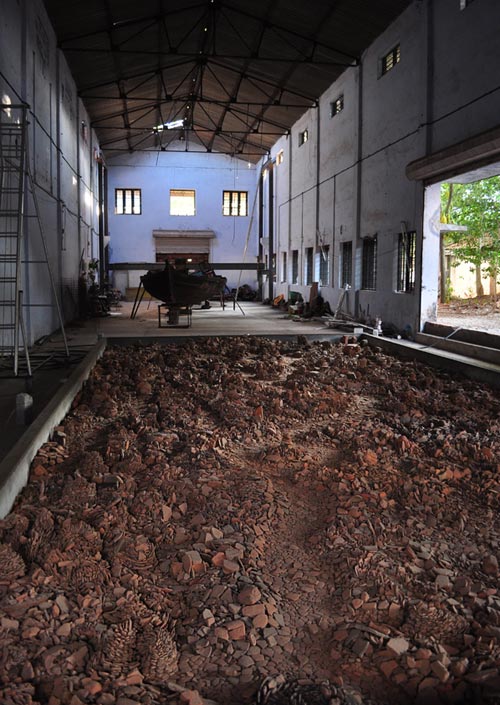
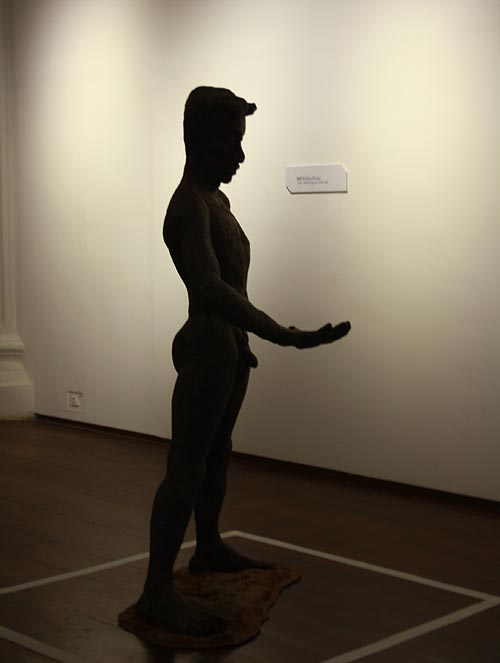
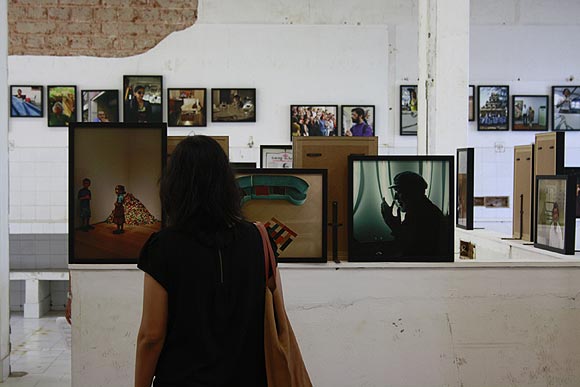

Comment
article